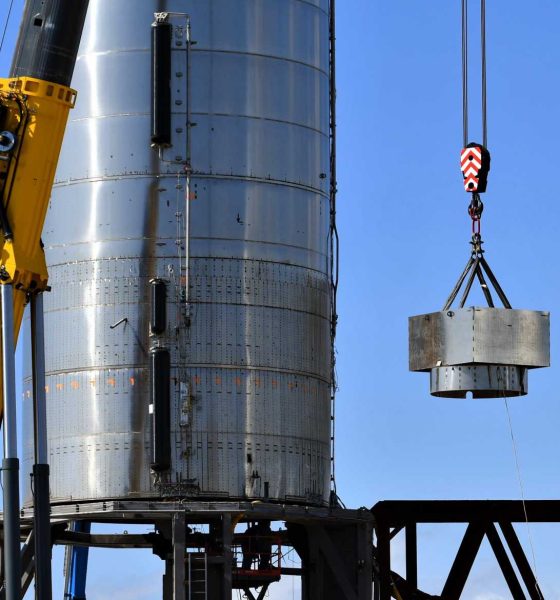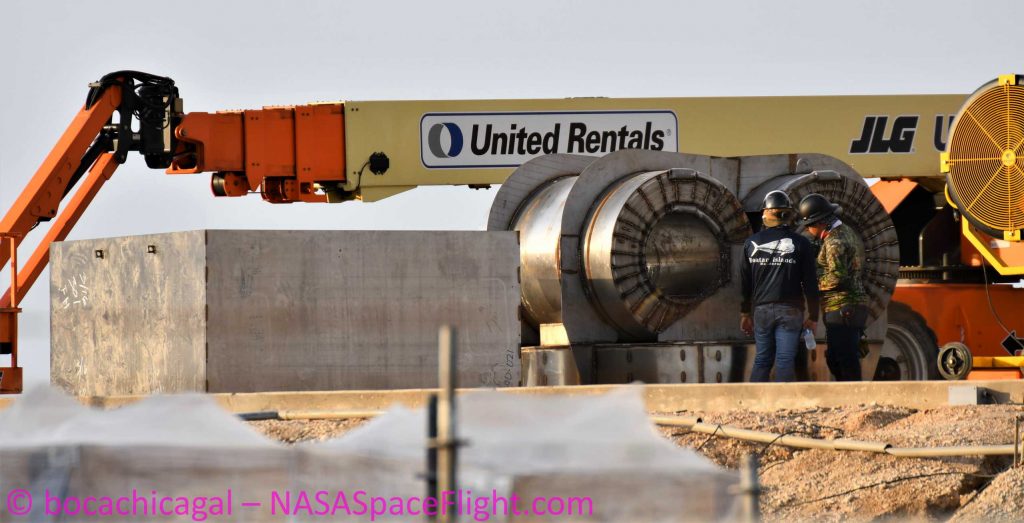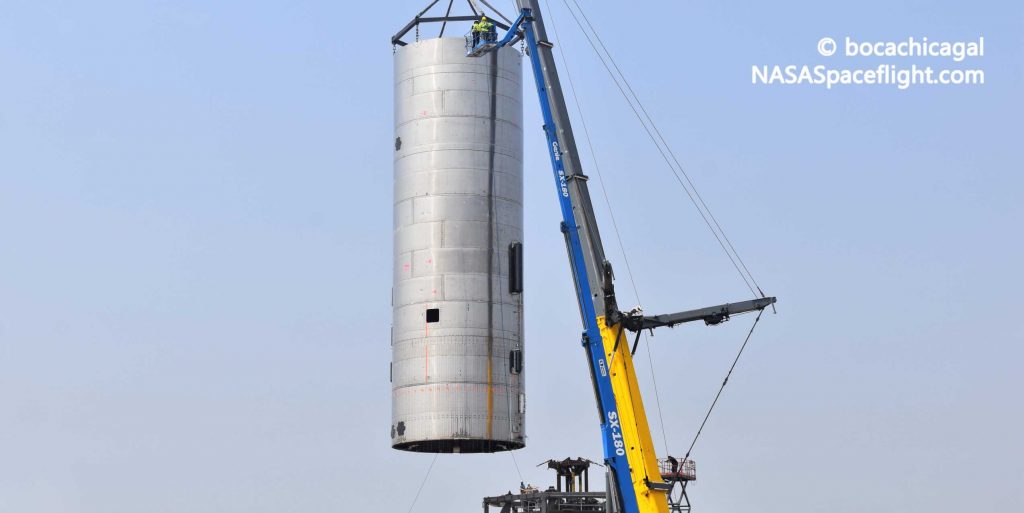

News
SpaceX Starship stacked with ballast for hop test debut
SpaceX has installed a custom-built ballast atop its fourth full-scale Starship prototype, a sign that the company is rapidly approaching the ship’s first Starhopper-style hop test.
Although CEO Elon Musk officially “redirected” SpaceX’s resources away from Starship’s first flight and towards Crew Dragon’s NASA astronaut launch debut, the company continues to work around the clock to ready Starship SN4 for the program’s biggest test yet. Designed with the goal of creating a fully-reusable, ultra-capable launch vehicle that is unprecedentedly affordable, SpaceX’s Starship spacecraft and Super Heavy booster have made impressive progress over the last 12 or so months.
In July and August 2019, Starhopper – a low-fidelity testbed and proof of concept – successfully performed two untethered hop tests, ultimately flying more than 150m (~500 ft) above ground before safely touching down. Three months later, the first full-scale Starship prototype was destroyed almost immediately after its first pressure test began, a failure that lead SpaceX to expedite factory upgrades. Just six months later, SpaceX has completed multiple successful tests, including pressure tests that pushed beyond the pressures needed for safe human spaceflight, several full wet dress rehearsals (WDRs) with live propellant, and three Raptor engine static fires. In fewer words, Starship is ready for its next big test: flight.

However, Starship SN4 currently has just one Raptor engine installed and will remain in that configuration for its inaugural hop, expected to reach a maximum altitude identical to Starhopper (150m/500ft). The odd configuration means that the rocket will be propelled by asymmetric thrust, as Starship’s ‘thrust puck’ engine section is designed to hold three Raptor engines in a triangular formation. Raptor is capable of producing up to 200 metric tons (~440,000 lbf) of thrust with an unclear level of throttle control (likely mediocre according to comments made by Elon Musk).
Impressively, although it might seem reasonable to assume that Starship SN4 is about as heavy as the ~120 ton Starhopper, the clear and present need to install substantial ballast suggests otherwise. Combined with comments made during SN4’s April 2020 transport from factory to launch site, it appears that even SpaceX’s early Starship engine sections weigh just 50-60 metric tons (110,000-125,000 lb) empty. That weight doesn’t account for the flaps, heat shield, nose section, or many other heavy components that orbital Starships will eventually need but is still impressive.


That impressive weight reduction, Raptor’s inability to safely throttle low, and the FAA’s lack of interest in dozens (up to hundreds) of tons of explosive propellant flying above or around populated areas poses its own challenges for the first full-scale Starship flight. The addition of ballast helpfully solves (or at least alleviates) several of those issues. Notably, ballast can prevent SpaceX from having to fuel Starship SN4 with dozens of extra tons of explosive propellant to counteract the high thrust of its single engine and permit a safe launch and landing.
At the same time, if Starship SN4’s wet weight is reduced by carrying less propellant during its first flight, that actually exacerbates the problem of Raptor’s small throttle range, as a lighter ship would be much harder to manage as the engine rapidly burns propellant and thus loses mass. With ballast, Raptor won’t have to throttle as low as it would otherwise have to to ensure a gentle rate of deceleration. Built out of sheet steel and two spare rolls of the same steel used to form Starship rings, Starship SN4’s new ballast likely increases its dry mass by some 50% or more (25+ metric tons).


Pending Crew Dragon’s inaugural astronaut launch, now scheduled no earlier than 3:22 pm EDT (19:22 UTC), May 30th after weather delayed the first May 27th launch attempt, Starship SN4 has no testing periods on the calendar at the moment. Speaking around May 23rd, Musk stated that the ship was likely at least a “few weeks” away from its flight debut, suggesting that the ship will perform another static fire test to prepare for its first hop as early as next week. Stay tuned for updates as SpaceX’s works towards two very exciting Crew Dragon and Starship milestones.
Check out Teslarati’s Marketplace! We offer Tesla accessories, including for the Tesla Cybertruck and Tesla Model 3.

Elon Musk
Elon Musk’s X will start using a Tesla-like software update strategy
The initiative seems designed to accelerate updates to the social media platform, while maintaining maximum transparency.

Elon Musk’s social media platform X will adopt a Tesla-esque approach to software updates for its algorithm.
The initiative seems designed to accelerate updates to the social media platform, while maintaining maximum transparency.
X’s updates to its updates
As per Musk in a post on X, the social media company will be making a new algorithm to determine what organic and advertising posts are recommended to users. These updates would then be repeated every four weeks.
“We will make the new 𝕏 algorithm, including all code used to determine what organic and advertising posts are recommended to users, open source in 7 days. This will be repeated every 4 weeks, with comprehensive developer notes, to help you understand what changed,” Musk wrote in his post.
The initiative somewhat mirrors Tesla’s over-the-air update model, where vehicle software is regularly refined and pushed to users with detailed release notes. This should allow users to better understand the details of X’s every update and foster a healthy feedback loop for the social media platform.
xAI and X
X, formerly Twitter, has been acquired by Elon Musk’s artificial intelligence startup, xAI last year. Since then, xAI has seen a rapid rise in valuation. Following the company’s the company’s upsized $20 billion Series E funding round, estimates now suggest that xAI is worth tens about $230 to $235 billion. That’s several times larger than Tesla when Elon Musk received his controversial 2018 CEO Performance Award.
As per xAI, the Series E funding round attracted a diverse group of investors, including Valor Equity Partners, Stepstone Group, Fidelity Management & Research Company, Qatar Investment Authority, MGX, and Baron Capital Group, among others. Strategic partners NVIDIA and Cisco Investments also continued support for building the world’s largest GPU clusters.
News
Tesla FSD Supervised wins MotorTrend’s Best Driver Assistance Award
The decision marks a notable reversal for the publication from prior years, with judges citing major real-world improvements that pushed Tesla’s latest FSD software ahead of every competing ADAS system.

Tesla’s Full Self-Driving (Supervised) system has been named the best driver-assistance technology on the market, earning top honors at the 2026 MotorTrend Best Tech Awards.
The decision marks a notable reversal for the publication from prior years, with judges citing major real-world improvements that pushed Tesla’s latest FSD software ahead of every competing ADAS system. And it wasn’t even close.
MotorTrend reverses course
MotorTrend awarded Tesla FSD (Supervised) its 2026 Best Tech Driver Assistance title after extensive testing of the latest v14 software. The publication acknowledged that it had previously criticized earlier versions of FSD for erratic behavior and near-miss incidents, ultimately favoring rivals such as GM’s Super Cruise in earlier evaluations.
According to MotorTrend, the newest iteration of FSD resolved many of those shortcomings. Testers said v14 showed far smoother behavior in complex urban scenarios, including unprotected left turns, traffic circles, emergency vehicles, and dense city streets. While the system still requires constant driver supervision, judges concluded that no other advanced driver-assistance system currently matches its breadth of capability.
Unlike rival systems that rely on combinations of cameras, radar, lidar, and mapped highways, Tesla’s FSD operates using a camera-only approach and is capable of driving on city streets, rural roads, and freeways. MotorTrend stated that pure utility, the ability to handle nearly all road types, ultimately separated FSD from competitors like Ford BlueCruise, GM Super Cruise, and BMW’s Highway Assistant.
High cost and high capability
MotorTrend also addressed FSD’s pricing, which remains significantly higher than rival systems. Tesla currently charges $8,000 for a one-time purchase or $99 per month for a subscription, compared with far lower upfront and subscription costs from other automakers. The publication noted that the premium is justified given FSD’s unmatched scope and continuous software evolution.
Safety remained a central focus of the evaluation. While testers reported collision-free operation over thousands of miles, they noted ongoing concerns around FSD’s configurable driving modes, including options that allow aggressive driving and speeds beyond posted limits. MotorTrend emphasized that, like all Level 2 systems, FSD still depends on a fully attentive human driver at all times.
Despite those caveats, the publication concluded that Tesla’s rapid software progress fundamentally reshaped the competitive landscape. For drivers seeking the most capable hands-on driver-assistance system available today, MotorTrend concluded Tesla FSD (Supervised) now stands alone at the top.
News
Elon Musk’s Grokipedia surges to 5.6M articles, almost 79% of English Wikipedia
The explosive growth marks a major milestone for the AI-powered online encyclopedia, which was launched by Elon Musk’s xAI just months ago.

Elon Musk’s Grokipedia has grown to an impressive 5,615,201 articles as of today, closing in on 79% of the English Wikipedia’s current total of 7,119,376 articles.
The explosive growth marks a major milestone for the AI-powered online encyclopedia, which was launched by Elon Musk’s xAI just months ago. Needless to say, it would only be a matter of time before Grokipedia exceeds English Wikipedia in sheer volume.
Grokipedia’s rapid growth
xAI’s vision for Grokipedia emphasizes neutrality, while Grok’s reasoning capabilities allow for fast drafting and fact-checking. When Elon Musk announced the initiative in late September 2025, he noted that Grokipedia would be an improvement to Wikipedia because it would be designed to avoid bias.
At the time, Musk noted that Grokipedia “is a necessary step towards the xAI goal of understanding the Universe.”
Grokipedia was launched in late October, and while xAI was careful to list it only as Version 0.1 at the time, the online encyclopedia immediately earned praise. Wikipedia co-founder Larry Sanger highlighted the project’s innovative approach, noting how it leverages AI to fill knowledge gaps and enable rapid updates. Netizens also observed how Grokipedia tends to present articles in a more objective manner compared to Wikipedia, which is edited by humans.
Elon Musk’s ambitious plans
With 5,615,201 total articles, Grokipedia has now grown to almost 79% of English Wikipedia’s article base. This is incredibly quick, though Grokipedia remains text-only for now. xAI, for its part, has now updated the online encyclopedia’s iteration to v0.2.
Elon Musk has shared bold ideas for Grokipedia, including sending a record of the entire knowledge base to space as part of xAI’s mission to preserve and expand human understanding. At some point, Musk stated that Grokipedia will be renamed to Encyclopedia Galactica, and it will be sent to the cosmos.
“When Grokipedia is good enough (long way to go), we will change the name to Encyclopedia Galactica. It will be an open source distillation of all knowledge, including audio, images and video. Join xAI to help build the sci-fi version of the Library of Alexandria!” Musk wrote, adding in a later post that “Copies will be etched in stone and sent to the Moon, Mars and beyond. This time, it will not be lost.”








